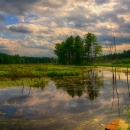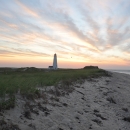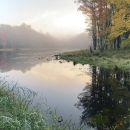About Us
Monomoy National Wildlife Refuge was established in 1944 to provide habitat for migratory birds. In 1970, the Monomoy Wilderness was established and today, covers 3,500 acres of the Refuge's 7,921 acres.
Our conservation priorities are to protect habitats critical to migratory bird for resting, nesting and feeding; spawning site for horseshoe crabs; and a place for gray seals to rest, give birth, and feed their pups, returning to the water to feed on fish, crustaceans, and shellfish.. With nearly half of the refuge designated as Wilderness we also seek to preserve the characters which are unique to wilderness areas.
Specific wildlife which use the refuge include: the federally protected piping plover, roseate tern, and red knot. At least 25 species of seabird, shorebird, waterfowl, and colonial water birds. The refuge also supports the largest nesting colony of common terns on the Atlantic seaboard, exceeding 13,000 pairs. Between 30,000-50,000 seals use the lands and waters around the refuge.
Sand stretches for eight miles off the elbow of Cape Cod, forming the barrier islands of Minimoy, North Monomoy, and South Monomoy, along with numerous islets and shoals. Refuge Headquarters is located on a 40-acre unit on Morris Island, and consists of a visitor center, beach, and trail system. The Refuge consists of varied habitats of oceans, salt and freshwater marshes, dunes, and freshwater ponds.
Monomoy NWR has several conservation claims to fame, which include:
- The beaches of Monomoy and Chatham have the highest concentration of nesting piping plovers in New England.
- The Refuge has among the highest concentrations of spawning horseshoe crabs in the state, whose eggs are a vital food resource for thousands of shorebirds.
- South Monomoy Island contains the largest gray seal haul-out site on the U.S. Atlantic Coast.
- Monomoy Wilderness is the only federally designated Wilderness Area in Southern New England.
- The refuge is also designated as a Western Hemisphere Shorebird Reserve Network (WHSRN) regional site,
an Important Bird Area (IBA), and a Marine Protected Area (MPA). - Monomoy Point Light Station and keeper’s house, located on South Monomoy Island, is listed on the National Register of Historic Places.
Wilderness Areas
Monomoy Wilderness was established in 1970. With surveys conducted in the year 2,000 and the constantly changing landscape of sandy islands, the wilderness area wilderness area
Wilderness areas are places untamed by humans. The Wilderness Act of 1964 allows Congress to designate wilderness areas for protection to ensure that America's pristine wild lands will not disappear. Wilderness areas can be part of national wildlife refuges, national parks, national forests or public lands managed by the Bureau of Land Management.
Learn more about wilderness area is estimated to be 3,500 areas. This acreage does not include exclusion areas for the lighthouse and remnants of 2 villages which existed 90 years ago on South Monomoy Island.
Despite being adjacent to highly popular Cape Cod tourist destinations, the Monomoy Wilderness offers opportunities which meet wilderness characteristics of solitude, naturalness, primitive and unconfined recreation. Its supplemental values are the vital and unique habitat this wilderness provides for migratory birds, tiger beetles, and horseshoe crabs.
For more information about Monomoy Wilderness and other wilderness areas visit Wilderness Connect.
Our Mission
The Service established Monomoy NWR in 1944 for the following purpose:
“… for use as an inviolate sanctuary, or for other management purpose, for migratory birds” — Migratory Bird Conservation Act (16 U.S.C. § 715d)
Throughout the initial designation process for the refuge, the Monomoy area was recognized as an “outstanding waterfowl area,” as “one of the finest shorebird beaches in North America” (Salyer 1938) and for the eelgrass (Zostera spp.) beds in shoal waters northwest of Inward Point on the Common Flats (Griffith 1938) that were described as “dense” beds in 1929 (Hotchkiss and Ekvall 1929). The biological values of this area helped define the refuge boundary.
In 1970, Congress designated approximately 2,600 acres of land as wilderness to become part of the NWPS, thereby preserving the wilderness character of the Monomoy Islands.
“In accordance with … the Wilderness Act…certain lands in the Monomoy National Wildlife Refuge, Massachusetts, which comprise about two thousand six hundred acres but excepting and excluding therefrom two tracts of land containing approximately ninety and one hundred and seventy acres, respectively and which are depicted on a map entitled “Monomoy Wilderness— Proposed” and dated August 1970, which shall be known as the Monomoy Wilderness”—an Act to Designate Certain Lands as Wilderness (Public Law 91-504, 16 U.S.C. § 1132(c)).
With the designation of national wilderness at Monomoy NWR, the original establishing refuge purpose of “management and protection of migratory birds,” was expanded to include “management and protection of wilderness character and values.”
Vision Statement:
Extending from the elbow of Cape Cod, Monomoy National Wildlife Refuge consists of an assembly of barrier beaches that includes some of New England’s last remaining wild seacoast. This dynamic, wilderness system of ocean, intertidal flats, salt and freshwater marshes, dunes and freshwater ponds, provides vital habitat for a vast array of diverse species. Monomoy NWR is world-renowned for its range of seasonal wildlife inhabitants. Seabirds, waterfowl, shorebirds, wading birds, land birds, horseshoe crabs, and seals rely upon the refuge for survival during various times of the year. Given the vital role that these lands and waters play in the survival of so many endangered, threatened, and special species, wildlife conservation and management will always be our first priority at Monomoy NWR.
The unique area that is Cape Cod allows us to reach large numbers of visitors from all over the world. Visitors will learn about the rich history of the refuge, experience unique recreational opportunities, view wildlife in a natural setting, and learn about the positive and negative impacts of human interactions with the refuge. Visitors will understand and appreciate how we manage the refuge, its habitats, and wildlife species. We will ensure that the number of visitors on the refuge is appropriate so as not to detract from a rich wilderness and wildlife experience.
As a regional and national role model, the refuge will provide scientific and technical leadership for wildlife and resource management that is adaptable to changing conditions. Talented, knowledgeable staff will continue to develop and foster partnerships with local, regional, national, and international organizations to assist in the management of Monomoy NWR and inform the conservation community of the work that we do. Monomoy NWR will continue to play a crucial role in the National Wildlife Refuge System by protecting this critical nesting, feeding, and resting area for migratory birds along the Atlantic Coast.
Our History
Monomoy NWR contains a variety of known cultural resources dating as far back as Paleo-Indian cultures. Specifically, Monomoy is within the indigenous homelands of the Wampanoag people who were also known as the People of First Light. They inhabited much of present day Massachusetts and Eastern Rhode Island.
Former locations of the historic Whitewash Village, seasonal cottages and camps, shipwrecks, and USCG lifesaving stations on South Monomoy Island. The most well known cultural resource on refuge lands is the Monomoy Point Light Station, which includes the lighthouse, keeper’s house, and small oil house. First built in 1823, this site is listed in the National Register of Historic Places.
The Service established Monomoy NWR in 1944 under a Declaration of Taking for the following purposes and under the following authorities: The Refuge Headquarters is located on a 40-acre unit on Morris Island, and consists of a visitor center, beach, and trail system.
The refuge is bounded by mean low water (an average of low tide levels) to the east and by a fixed boundary that was set when the refuge was established. This website includes a statement regarding the refuge boundary.
Other Facilities in this Complex
Monomoy National Wildlife Refuge is managed as part of the Eastern Massachusetts National Wildlife Refuge Complex.
Situated along the Atlantic Flyway in Massachusetts, the Eastern Massachusetts National Wildlife Refuge Complex is comprised of eight ecologically diverse refuges. The eight individual refuges include inland and coastal wetlands, forests, grasslands, and barrier beaches that provide important habitat for migratory birds, mammals, plants, reptiles and amphibians.



